August 30, 2010
August 29, 2010
Old School Harlotry
Topless Robot has a thorough breakdown of the infamous Harlot table from the 1st Edition Dungeon Master's Guide: link (NSFW language).
I wonder what the XP table for the Rich Panderer looks like?
I wonder what the XP table for the Rich Panderer looks like?
August 27, 2010
Lazy Friday Fantasy Metal Post: The Sword - Fire Lances of the Ancient Hyperzephyrians
There has been a lot of post-apocalyptic game talk recently, so this tracked seems very appropriate. It also makes me think of Beyond the Black Gate's raven lance.
Oh, and if you want some "real" post-apocalyptic action, check out this three-day Mad Max reenactment (is it a reenactment if you're enacting something that hasn't happened yet?).
Oh, and if you want some "real" post-apocalyptic action, check out this three-day Mad Max reenactment (is it a reenactment if you're enacting something that hasn't happened yet?).
August 26, 2010
Official Internet Meme of the OSR
So given the reactions to my post yesterday, I think we have found the official Internet meme of the OSR. Please use it as you see fit.
Disclaimer: I did not create this picture. I first encountered it on Fark.com and did a Google image search for it yesterday as it seemed appropriate.

Disclaimer: I did not create this picture. I first encountered it on Fark.com and did a Google image search for it yesterday as it seemed appropriate.

August 25, 2010
Frog God Games, the OSR, and a big ol' "Huh?"
Ok, so first off, I'm a hardcore Necromancer Games fanboy. Without a doubt, they have
 made some of my favorite RPG products. So when Bill Webb (a.k.a. Tsathogga), an NG co-founder, announced its resurrection as Frog God Games, I was stoked. I still am. Bill had been more of the silent partner at NG (Clark Peterson, a.k.a. Orcus, being the more vocal spokesman), so it was interesting to see Bill grab the wheel.
made some of my favorite RPG products. So when Bill Webb (a.k.a. Tsathogga), an NG co-founder, announced its resurrection as Frog God Games, I was stoked. I still am. Bill had been more of the silent partner at NG (Clark Peterson, a.k.a. Orcus, being the more vocal spokesman), so it was interesting to see Bill grab the wheel.
Recently, FGG made some big news by announcing they'd be producing a new edition of OSR favorite, Swords & Wizardry. The OSR community rejoiced.
Then folks found some interesting text on FGG's About Us page and there has not been much rejoicing. I have put the entire text so you, Gentle Reader, can see the whole context. I have underlined the shit-storm causing text, though:
----
"Who We Are
We consist of old grognard gamers, including a brilliant layout guy, and a cartographer who was not even a gamer when we recruited him. We have more than a few writing credits to our name, and have decided after dealing with publishers, printers and middlemen to head off on our own and make some books. We have developed friendships with, and worked with the best and most famous writers in the industry. We are the real deal.
Who We Aren't
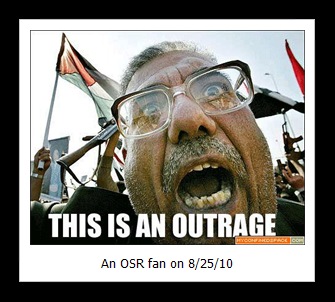
We are not the guys who are going to offer bargain basement junk for a quick buck. We won't sell you hand drawn maps and clip art laid out by amateurs and posted up on Lulu.com as a cheap book that you look at and discard.
We won't fill your players coffers with millions of gold pieces and powerful magic items either, at least not without great efforts. Our encounters won't be "balanced" to make sure no one dies, and a 3rd level monster may or may not have 50.2 gp (like its supposed to in certain rule books). Death will be frequent, but fair, and players who fail to use their heads will surely lose them.
After all, Tsathogga's special attack is "eats 1d6 adventurers per round". Adventurers taste like chicken....errrr, flies."
---
That text has been on the FGG site from day one. I know that because I read it then and thought it was odd. No one took notice in the OSR-o-sphere until the recent FGG/S&W announcement (understandably so, since FGG had only talked about Pathfinder products up to that point).
So what do I think of this? That text had me scratching my head when I first read it and does so now. Bill Webb has stated on the NG forums that he plays 0e D&D via Swords & Wizardry (available, uhm, on Lulu: link). He has stated he has committed to articles for Knockspell, a well-known OSR magazine.
I think the words were very poorly chosen, to say the least. But Bill seems to have inadvertently lumped in the very game he plays. That tells me this isn't simply "the OSR was crap until now!" It will be interesting to hear his explanation. I get why fans are upset, but I want to hear his response.
If nothing else, I think James Raggi's response kicks ass: link

Recently, FGG made some big news by announcing they'd be producing a new edition of OSR favorite, Swords & Wizardry. The OSR community rejoiced.
Then folks found some interesting text on FGG's About Us page and there has not been much rejoicing. I have put the entire text so you, Gentle Reader, can see the whole context. I have underlined the shit-storm causing text, though:
----
"Who We Are
We consist of old grognard gamers, including a brilliant layout guy, and a cartographer who was not even a gamer when we recruited him. We have more than a few writing credits to our name, and have decided after dealing with publishers, printers and middlemen to head off on our own and make some books. We have developed friendships with, and worked with the best and most famous writers in the industry. We are the real deal.
Who We Aren't

We are not the guys who are going to offer bargain basement junk for a quick buck. We won't sell you hand drawn maps and clip art laid out by amateurs and posted up on Lulu.com as a cheap book that you look at and discard.
We won't fill your players coffers with millions of gold pieces and powerful magic items either, at least not without great efforts. Our encounters won't be "balanced" to make sure no one dies, and a 3rd level monster may or may not have 50.2 gp (like its supposed to in certain rule books). Death will be frequent, but fair, and players who fail to use their heads will surely lose them.
After all, Tsathogga's special attack is "eats 1d6 adventurers per round". Adventurers taste like chicken....errrr, flies."
---
That text has been on the FGG site from day one. I know that because I read it then and thought it was odd. No one took notice in the OSR-o-sphere until the recent FGG/S&W announcement (understandably so, since FGG had only talked about Pathfinder products up to that point).
So what do I think of this? That text had me scratching my head when I first read it and does so now. Bill Webb has stated on the NG forums that he plays 0e D&D via Swords & Wizardry (available, uhm, on Lulu: link). He has stated he has committed to articles for Knockspell, a well-known OSR magazine.
I think the words were very poorly chosen, to say the least. But Bill seems to have inadvertently lumped in the very game he plays. That tells me this isn't simply "the OSR was crap until now!" It will be interesting to hear his explanation. I get why fans are upset, but I want to hear his response.
If nothing else, I think James Raggi's response kicks ass: link
August 23, 2010
Garhelm - The Map
This is Garhelm:
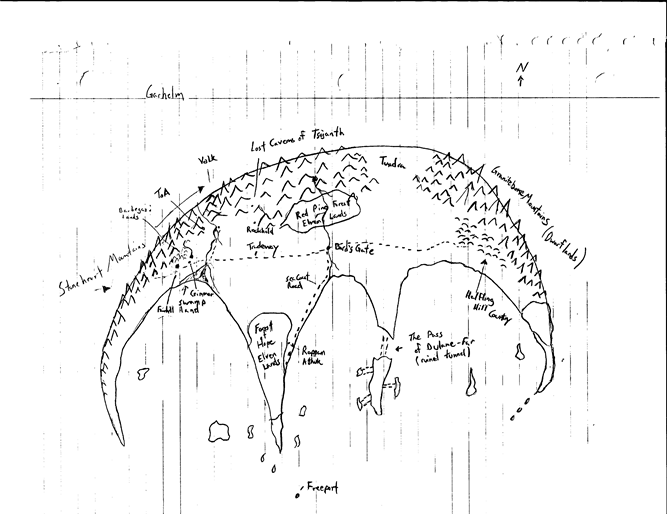
If you want a better look, trying downloading the PDF: link
Yep, as you can tell from the scan, I banged it out on some old notebook paper. I make no claims to be a cartographer, so I have no clue if such a landmass is even feasible. I think it looks pretty cool, though, so I don't really care. There is no scale as I wasn't really sure what I wanted it to be and figured I'd tackle that as needed. I just wanted a rough idea of the campaign world so I could place important locations, namely cities and dungeons. You'll note names from the standard Necromancer Games (NG) heavy hitters (the Stoneheart Mountains from Tomb of Abysthor, Fairhill from the Crucible of Freya, Bard's Gate, the Vault of Larin Karr, and, of course, Rappan Athuk) as well as The Lost Caverns of Tsojcanth coming out of retirement. Yep, that is Green Ronin's Freeport way to the south.
I had big plans for the campaign, but they weren't realized after the deaths in the Vault of Larin Karr. My general plan was for a sandbox campaign once the party had finished up there. I planned to include a world map with the loot at some point and then let the players have at it. Since I had never shown the map before, I was hoping that would be kind of a neat surprise (i.e., the idea being that few people in Garhelm have much sense of what their world actually looked like).
I started the face-to-face campaign in Fairhill, which is the setting of NG's The Crucible of Freya. I don't own that module (although I did play it as a player under Sam's DMing), but I used the free maps from NG's site [link (you’ll need to scroll down a bit)] and added my own NPCs and descriptions. That worked out quite well and allowed me to impart the flavor of Garhelm right from the start. I might write those up if I have a chance (unfortunately, I don't have those as electronic files, so no easy cutting and pasting). I don't think I used Fairhill for the online campaign, likely because Sam was playing as a character.
Anyhow, here is a key of sorts to help you decipher things (I left off anything I thought was self-explanatory):
 So, there you have it. Garhlem. Some time in the future, I’ll put up my version of Fairhill and perhaps some of the home brew adventures I had for this campaign.
So, there you have it. Garhlem. Some time in the future, I’ll put up my version of Fairhill and perhaps some of the home brew adventures I had for this campaign.

If you want a better look, trying downloading the PDF: link
Yep, as you can tell from the scan, I banged it out on some old notebook paper. I make no claims to be a cartographer, so I have no clue if such a landmass is even feasible. I think it looks pretty cool, though, so I don't really care. There is no scale as I wasn't really sure what I wanted it to be and figured I'd tackle that as needed. I just wanted a rough idea of the campaign world so I could place important locations, namely cities and dungeons. You'll note names from the standard Necromancer Games (NG) heavy hitters (the Stoneheart Mountains from Tomb of Abysthor, Fairhill from the Crucible of Freya, Bard's Gate, the Vault of Larin Karr, and, of course, Rappan Athuk) as well as The Lost Caverns of Tsojcanth coming out of retirement. Yep, that is Green Ronin's Freeport way to the south.
I had big plans for the campaign, but they weren't realized after the deaths in the Vault of Larin Karr. My general plan was for a sandbox campaign once the party had finished up there. I planned to include a world map with the loot at some point and then let the players have at it. Since I had never shown the map before, I was hoping that would be kind of a neat surprise (i.e., the idea being that few people in Garhelm have much sense of what their world actually looked like).
I started the face-to-face campaign in Fairhill, which is the setting of NG's The Crucible of Freya. I don't own that module (although I did play it as a player under Sam's DMing), but I used the free maps from NG's site [link (you’ll need to scroll down a bit)] and added my own NPCs and descriptions. That worked out quite well and allowed me to impart the flavor of Garhelm right from the start. I might write those up if I have a chance (unfortunately, I don't have those as electronic files, so no easy cutting and pasting). I don't think I used Fairhill for the online campaign, likely because Sam was playing as a character.
Anyhow, here is a key of sorts to help you decipher things (I left off anything I thought was self-explanatory):
- Barbegazi lands: Barbegazi are a neat, semi-evil race ice gnomes from the Tome of Horrors II
(and, I just realized, actual Swiss mythology: link). You can check them out in the ToH II free sample: link
- ToA: Tomb of Abysthor
- Volk: Vault of Larin Karr
- The Pass of Dulane-Far: An underground, underwater tunnel connecting the mainland to a severed peninsula. Tunnels also connected this island to other nearby islands. I believe I envisioned this pass having been closed off to contain the horrors of the island and the tunnels, but I’m not sure. I do think it is one of the cooler things on the map.
 So, there you have it. Garhlem. Some time in the future, I’ll put up my version of Fairhill and perhaps some of the home brew adventures I had for this campaign.
So, there you have it. Garhlem. Some time in the future, I’ll put up my version of Fairhill and perhaps some of the home brew adventures I had for this campaign. August 20, 2010
Lazy Friday Fantasy Metal Post: Elvenking - A Riddle of Stars
I know I already made a post today, but this song is too great not to share.
Garhelm - The Blood of the Einherjar
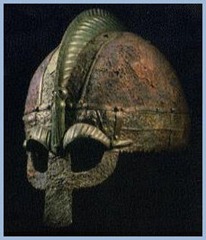
I had hoped that allowing any race to freely multi-class with Barbarian would encourage hearty PCs (see the "Classes" section of this post link). However, it pushed players to take a level of Barbarian at first level, whether they really wanted it or not. Besides perhaps ending up with a party solely composed of Barbarians (which seems bad-ass to me, actually), it also meant that if a player took Barbarian at first level simply to have a beefy hit point base (mmm… beefy), he’d miss out on the initial first level perks of the actual desired class (e.g., Wizard, Rogue, etc.). On the other hand, if he didn’t take the Barbarian class at first level, the rule sort of punished him by not giving him that nice 12 hit point base.
This didn’t occur to me until a player voiced his frustration after a TPK. So I created “The Blood of the Einherjar” rule. Unfortunately, player interest was completely nil at that point (can’t say I blame them), so this rule was never really enacted or tested because the campaign had dissolved.
The Blood of the Einherjar
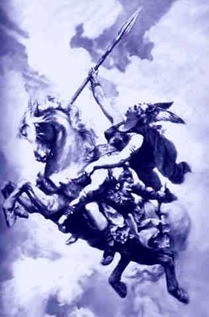 The Einherjar are the heroes who have died with great bravery on the battle fields and have been taken by the Valkyries to Valhalla. When Valhalla emptied to purge Garhelm of the Demons and Devils, Odin and Thor led the Einherjar into battle. Some of these warriors found companionship with the natives of Garhelm during this time. Although the Einherjar departed once Garhelm was cleansed, their children remain. These lucky few have the blood of the Einherjar flowing through their veins. These fortunate ones are destined for great deeds. They are the heroes of the Third Age.
The Einherjar are the heroes who have died with great bravery on the battle fields and have been taken by the Valkyries to Valhalla. When Valhalla emptied to purge Garhelm of the Demons and Devils, Odin and Thor led the Einherjar into battle. Some of these warriors found companionship with the natives of Garhelm during this time. Although the Einherjar departed once Garhelm was cleansed, their children remain. These lucky few have the blood of the Einherjar flowing through their veins. These fortunate ones are destined for great deeds. They are the heroes of the Third Age.What does this mean in game terms? This means that any PC, whether he knows it or not, has the blood of the Einherjar coursing through him. As such, he is born for battle. All PCs, in effect, start off at 2nd level, but in a particular fashion. Every PC begins with a complimentary Barbarian level to implement as he wishes. In practice this means you can use the Barbarian level as your first level or as your second. This will mainly be determined by what you actually want to play. If you plan to play a Wizard, you would most likely take your first level in Wizard to make the most of the skill points and such, and then add on the Barbarian level afterwards. However, regardless of which class is technically your first class, you will start with 12 HP + Con bonus. For example, if you decide to play a Wizard, you will begin with 12 HP + Con bonus + 1d4 HP + Con bonus. The second HD will be rolled as normal (i.e., with the DM present). [As cool as I think it would be to have an entire party with the Rage ability, if I revive Garhelm, I will give the players the option of selecting a level of Fighter or Barbarian (and they’d get the standard Fighter 10 HP + Con bonus instead of the Barbarian's 12 HP + Con bonus to start). This fits the theme and purpose just as well and gives a bit more variety to the concept.]
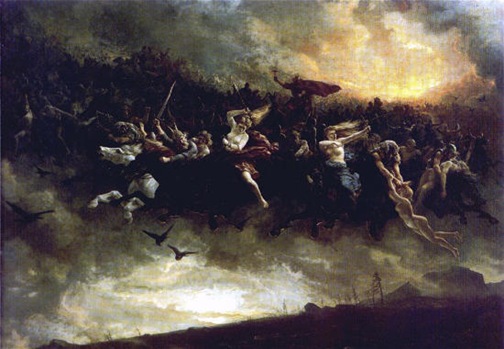
August 19, 2010
Garhelm – More Setting-Specific Rules
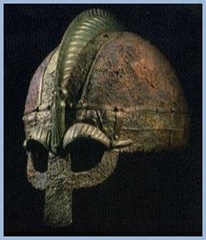 I’ve been digging through my old files (both paper and electronic) and have realized at some point I revised my initial rule-set. Both of the Garhelm campaigns were played over four years ago (egad, time flies), so I’m not certain when certain rules were in effect. I am fairly certain those in my first rules post were used consistently. I’m not sure about the following ones, unless otherwise noted below. In any event, here are a few more rules, again with annotation.
I’ve been digging through my old files (both paper and electronic) and have realized at some point I revised my initial rule-set. Both of the Garhelm campaigns were played over four years ago (egad, time flies), so I’m not certain when certain rules were in effect. I am fairly certain those in my first rules post were used consistently. I’m not sure about the following ones, unless otherwise noted below. In any event, here are a few more rules, again with annotation.Detect Chaos/Evil/Good/Law
- The detect chaos/evil/good/law spell and similar spell-like abilities do not function in regard to sentient beings. What is evil to one may be not be evil to another. However, the spell does function for insentient entities, such as magic weapons or locations, because such effects are typically a function of magic.
- From a gaming standpoint, detect chaos/evil/good/law and similar spells and abilities often rob role-playing encounters of their worth.
- [I believe this rule was used throughout both campaigns. I have never liked the problems that result from this spell. On one hand, it makes things easier: “If it’s evil, we kill it.” On the other hand, it makes things more complex:“Is it really a good action to kill an evilly aligned orc child?” or “Is it really a good action to harry any NPC in the bar that detects as evil?”
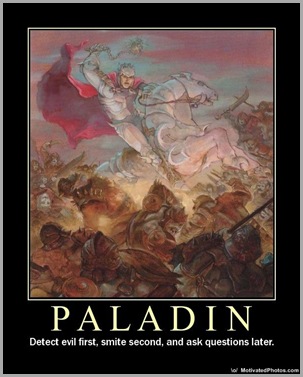 Given that I did not mention *protection* from chaos/evil/good/law spells in the rules, I likely let them work normally. I might tweak that and let such spells work only for outsiders or other beings that are inherently tied to their alignment. For example, a demon is in a sense Chaotic Evil incarnate, so it seems logical that wards against a demon should work. A gnoll, on the other hand, is more of a natural being and not inherently evil from birth.
Given that I did not mention *protection* from chaos/evil/good/law spells in the rules, I likely let them work normally. I might tweak that and let such spells work only for outsiders or other beings that are inherently tied to their alignment. For example, a demon is in a sense Chaotic Evil incarnate, so it seems logical that wards against a demon should work. A gnoll, on the other hand, is more of a natural being and not inherently evil from birth. - Quite frankly, I’m ready to pitch alignment altogether. It feels too forced and it seems players and DMs always find a rationale for a character’s/NPC’s action, regardless of his alignment. Polymythic Steve and I had an interesting IM chat a few weeks back about alignment. One of these days I’ll get around to blogging about it, but it started from this question: “In a democracy, if you can detect evil, should evil people be allowed to vote?”]
Raise Dead [I had two versions of this rule, both are included below.]
- [Version 1] The raise dead spell is available, but has been modified. A raised character does not lose a character level, but instead, as with previous editions, loses a point of Constitution. If the character’s Constitution reaches zero, he cannot be raised. The material component for raise dead is no longer a 1000 gp diamond. Instead, the caster must sacrifice a quantity of magic items relative to the strength of the character’s soul (i.e., his level). There is not a hard and fast rule regarding the proper sacrificial amount. The DM will use his discretion in such matter.
- [Version 2] The raise dead functions as described in the 3.5 Player’s Handbook except for the material component. Instead of a 5000 gp diamond, one or more willing participants much sacrifice some of their life force to restore the life of the recipient. In game terms, they must sacrifice a total of XPs equal to the minimum XP for the recipient’s former level (i.e., before the level loss of being raised). For example, to raise a 2nd level character, four PCs would lose 500 XP each. Note: each participant must sacrifice an equal share. The caster can choose to participate in the sacrifice, but can only do so if the XP loss would not cause him to lose access to the raise dead spell.
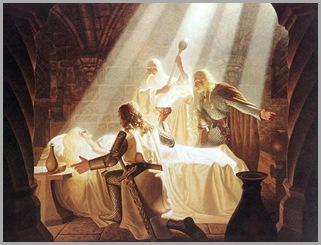
- [At the time I believed players weren’t sufficiently penalized for PC death and I didn’t like the whole concept of buying back your dead. Version 1 also doubled as a handy way to ensure the party didn’t become overly loaded with magic loot. I quite like the role-play concept of Version 2: the party giving of its own life to bring back the dead makes more sense (in a fantastical way) and is a much greater sacrifice than loot. On the other hand, it sort of feels like that scene in Full Metal Jacket where the rest of the troop is punished for Private Pile’s actions (NSFW link). I’ve come full circle on raise dead and now make it fairly easy for players to bring back the fallen (see my current house rules). I’ve embraced the “game” part of “role-playing game” and don’t sweat it.]
- If a PC dies and cannot be raised or resurrected, the player must roll a new PC. To ease matters for the gaming group (DM and players alike), the new PC will start at 2nd level. The PC will receive the standard HP for first level (i.e., maximum), but must roll his 2nd level hit die in the DM’s presence. The PC will begin with the standard 1st level starting money for his class.
- [I’m not sure what this was about because I can’t remember what level the PCs started at.]
- All die rolls that fall off the table must be re-rolled on the table. No exceptions.
- If a rolled die comes to rest without a discernable result (e.g., the die lands in a crack on the table, etc.), the die is to be re-rolled. No exceptions.
- [This might seem like overkill, but I include this in my house rules to this date.]
- [I don’t remember anyone actually using these points. It seems like the players kept saving them for a rainy day that never happened. Again, although I originally had some house rule luck points in mind, I opted for what I now consider overly complex official rules. If I ever wanted something like this again, I’d just let the players earn luck points for good game play and let them use it to re-roll a die roll.]
- Characters gain a number of action points equal to 2 + one-half their character level, rounded down, at 1st level and every time they attain a new level.
- Action points provide characters with the means to affect game play in significant ways. A character can spend 1 action point to alter a single d20 roll used to make an attack, a skill check, an ability check, a level check, or a saving throw.
- When a character spends 1 action point to improve a d20 roll, add 1d6 to the d20 roll to help meet or exceed the target number. A character can declare the use of 1 action point to alter a d20 roll after the roll is made—but only before the DM reveals the result of that roll (whether the attack or check or saving throw succeeded or failed) [I find this bit particularly lame. It turns into a game of How Well Can the Players Read the DM’s Reaction]. When possible, the player should state his intention to spend an action point before the die is rolled. For example, “I may use an action point on this attack roll.”
- A character can’t use an action point on a skill check or ability check when he or she is taking 10 or taking 20.
- A character can only spend 1 action point in a round.
- Depending on the character level (see the table below), he or she may be able to roll more than one d6 when spending 1 action point. If the character does so, apply the highest result and disregard the other rolls.
| Character Level | Action Point Dice Rolled |
| 1st – 7th | 1d6 |
| 8th – 14th | 2d6 |
| 15th – 20th | 3d6 |
August 5, 2010
One Gamer, a Million T-Shirts
Ok, may be not literally a million, but my buddy Dave "The Knave" has a shit load. He is posting a picture of himself in a different t-shirt from his collection each day. Check out his "Too Many T-Shirts" project: link (he also has a Flickr account for it: link). Take a gander...
August 4, 2010
Dungeons and Digressions Frugal Homemade Game Table
My father-in-law passed away this week and I'm not much in the mood for posting. I will return to my Garhelm stuff when the mood strikes me.
In the mean time, Ze Bulette at Dungeons and Digressions has posted a nice, cheap homemade game table. Check it out: link
In the mean time, Ze Bulette at Dungeons and Digressions has posted a nice, cheap homemade game table. Check it out: link
Subscribe to:
Posts (Atom)


